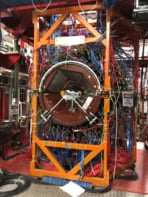The observation of neutrino oscillations - and hence neutrino mass - by the Super-Kamiokande experiment last year was one of the major physics discoveries of the 1990s. However, a team of US scientists is now proposing that the results can be explained by a new phenomenon - neutrino decay. Their model can, they claim, account for all neutrino anomalies with just three flavours of neutrino and is consistent with all experimental results to date. The decay model also implies neutrino mass (Phys. Rev. Lett. 82 2640).
According to the Standard Model of particle physics, the three types of neutrinos – electron, muon and tau neutrinos – have zero mass. But the number of atmospheric neutrinos – muon neutrinos created by interactions between cosmic rays and nuclei in the atmosphere – detected in experiments is significantly less than that predicted by the Standard Model. The Super- Kamiokande results suggest that muon neutrinos can ‘oscillate’ into tau neutrinos, and vice versa. This can only happen if neutrinos have mass.
Now John Learned of the University of Hawaii, one of the original Super-Kamiokande team, and colleagues suggest that the same results can be accounted for by neutrino decay. They suggest two scenarios called the Dirac and Majorana decay models. In the Dirac model, neutrinos decay into undetectable particles, while in the Majorana model, muon neutrinos decay into anti-tau neutrinos, which could be detected.
According to their calculations, the neutrinos would have a mass greater than 0.316 eV – larger than the 0.07 eV suggested by Super-Kamiokande – and a lifetime of approximately 10-11 seconds. However, only the Majorana model appears to be compatible with the number of neutrinos detected following the explosion of the 1987 supernova.



